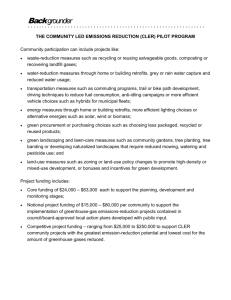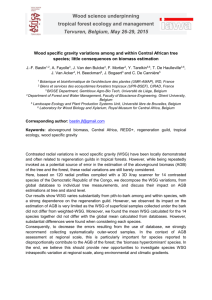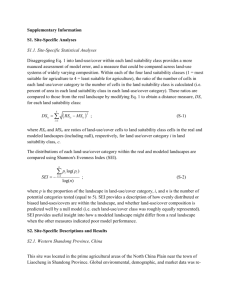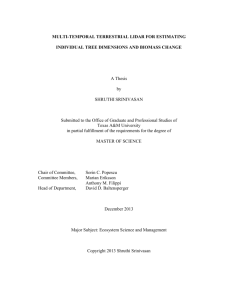Supplementary Info
advertisement
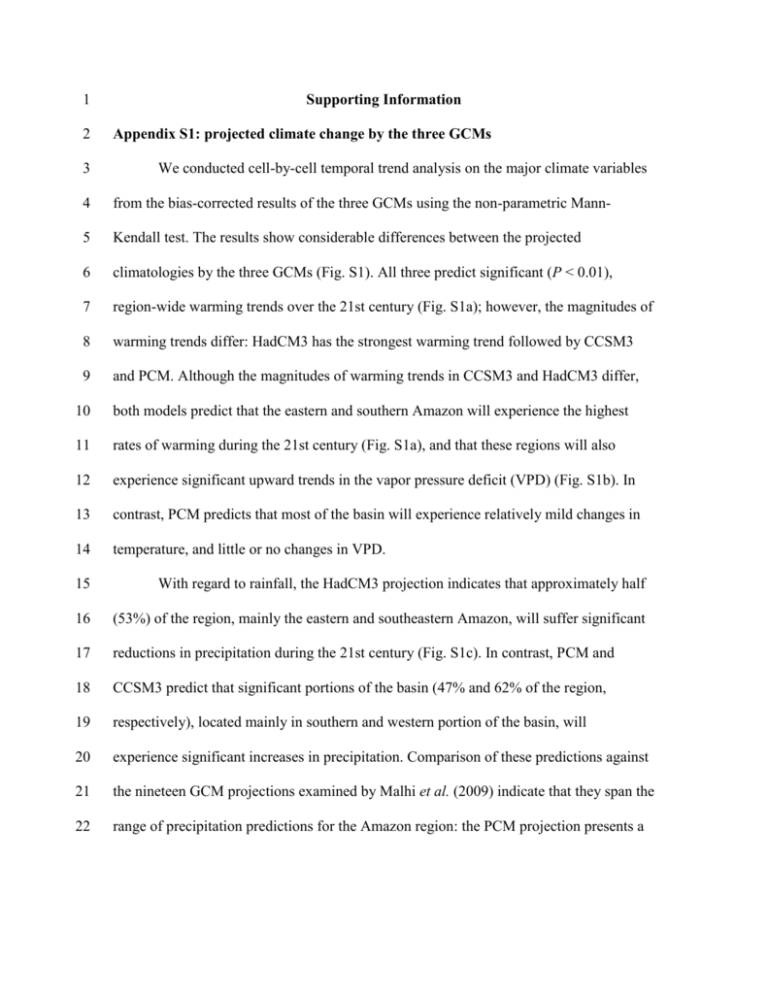
1 2 3 Supporting Information Appendix S1: projected climate change by the three GCMs We conducted cell-by-cell temporal trend analysis on the major climate variables 4 from the bias-corrected results of the three GCMs using the non-parametric Mann- 5 Kendall test. The results show considerable differences between the projected 6 climatologies by the three GCMs (Fig. S1). All three predict significant (P < 0.01), 7 region-wide warming trends over the 21st century (Fig. S1a); however, the magnitudes of 8 warming trends differ: HadCM3 has the strongest warming trend followed by CCSM3 9 and PCM. Although the magnitudes of warming trends in CCSM3 and HadCM3 differ, 10 both models predict that the eastern and southern Amazon will experience the highest 11 rates of warming during the 21st century (Fig. S1a), and that these regions will also 12 experience significant upward trends in the vapor pressure deficit (VPD) (Fig. S1b). In 13 contrast, PCM predicts that most of the basin will experience relatively mild changes in 14 temperature, and little or no changes in VPD. 15 With regard to rainfall, the HadCM3 projection indicates that approximately half 16 (53%) of the region, mainly the eastern and southeastern Amazon, will suffer significant 17 reductions in precipitation during the 21st century (Fig. S1c). In contrast, PCM and 18 CCSM3 predict that significant portions of the basin (47% and 62% of the region, 19 respectively), located mainly in southern and western portion of the basin, will 20 experience significant increases in precipitation. Comparison of these predictions against 21 the nineteen GCM projections examined by Malhi et al. (2009) indicate that they span the 22 range of precipitation predictions for the Amazon region: the PCM projection presents a 23 slightly warmer but wetter future climate, while the HadCM3 projection represents an 24 extremely hot and dry scenario and the CCSM3 projection falls in between. 25 26 Fig. S1. Maps of temporal trends from 2009 to 2100 in (a) annual air temperature, (b) 27 vapor pressure deficit and (c) precipitation from the bias-corrected projections of three 28 GCMs (i.e. PCM, CCSM3, and HadCM3); grey areas denote non-significant trends with 29 90% confidence. 30 Appendix S2: spatial patterns of the Business-As-Usual and Governance land-use 31 scenarios in Amazonia 32 The Global Land-Use dataset (GLU) incorporates the SAGE-HYDE 3.3.1 dataset 33 and provides global land-use transitions on a 1° grid from 1700 to 1999 (Hurtt et al., 34 2006). The Business-As-Usual (BAU) and Governance (GOV) datasets provide yearly 1- 35 km horizontal resolution land-use maps from 2002 to 2050. Consistent land-use transition 36 data for the entire period (1700–2100) were produced by following the procedure: (1) the 37 1-km BAU and GOV land-use maps were used to calculate the fractions of the three 38 land-use types for each 1° grid cell; (2) linear interpolation was used to connect the 1999 39 GLU land-use map to the 2008 GOV land-use map to produce continuous land-use maps 40 for the 2000–2008 period; (3) the land-use transition rates between 2000 and 2008 were 41 computed from the interpolated land-use maps; (4) the BAU and GOV land-use maps for 42 the 2009–2050 period were converted to their respective land-use transition rates for the 43 same period; and (5) BAU and GOV land-use transition rates were extrapolated from 44 2050 to 2100 by assuming the continuation of the same transition rates in 2050 until no 45 forest left in the grid cells. 46 47 Fig. S2. Spatial patterns of land-use composition in 2100 under the (a) GOV and (b) 48 BAU scenarios; the projected rates of land-use transformation were derived and extended 49 from Soares-Filho et al. (2006). 50 51 Appendix S3: evaluation of the biosphere models' performance In this study, we assessed the three biosphere models' predictive capabilities by 52 comparing modeled above-ground live biomass (AGB) and percent tree cover against 53 two sets of satellite remote sensing (RS) derived AGB estimates (Baccini et al., 2012, 54 Saatchi et al., 2011) and the MODIS Collection 5 MOD44B percent tree cover product 55 (DiMiceli et al., 2011), respectively. The Baccini et al. (2012), Saatchi et al. (2011), and 56 MOD44B data have nominal spatial resolutions of 500m, 1km, 500m, respectively. We 57 first aggregated these data to 1-degree and then compared them with our model results. 58 Both of the two RS biomass products were produced using a combination of data from 59 spaceborne LiDAR, optical and microwave imagery, and in situ inventory plots. An 60 evaluation of models' performance against site-level measurements of carbon fluxes and 61 aboveground biomass dynamics can be found in an ongoing study (Levine et al., The role 62 of short-term climate variability in governing Amazonian biomass dynamics, in 63 preparation) and Powell et al. (2013). 64 Although there are non-negligible discrepancies between the two RS products, 65 across the models, and between the models and RS products, the model predictions of 66 AGB show a similar spatial gradient to the satellite-derived estimates of regional AGB, 67 with AGB increasing from the southern and southeastern dry savanna zones to the 68 western and northeastern dense, moist forest regions (Fig. S3). ED2 AGB agrees well 69 with the RS AGB in these high biomass regions, but tends to underestimate AGB in low 70 biomass regions (Fig. S3a,d-f). IBIS AGB estimates are systematically lower than the RS 71 estimates in areas of high biomass but higher in areas of low biomass (Fig. S3b,d-f), 72 while JULES AGB is systematically higher than the RS AGB (Fig. S3c-f). A recent study 5 73 by Levine et al. (2014) compared site-level AGB estimates from the ED2 model and the 74 above two RS biomass products with the measurements of the RAINFOR network(Malhi 75 et al., 2002), and found that these model and RS estimates are qualitatively consistent 76 with that observed in the RAINFOR plots. 77 To more quantitatively describe the vegetation structure, we calculate the percent 78 tree cover (𝑓𝑡𝑟𝑒𝑒𝑐𝑜𝑣𝑒𝑟 ) using the fully projected tree foliage cover by following Kucharik 79 et al. (2000): 𝑓𝑡𝑟𝑒𝑒𝑐𝑜𝑣𝑒𝑟 = 1 − exp(−0.5 ∙ 𝐿𝐴𝐼𝑡𝑟𝑒𝑒 ), where 0.5 is the canopy extinction 80 coefficient, and 𝐿𝐴𝐼𝑡𝑟𝑒𝑒 is the total leaf area index of all tree plant function types. Percent 81 tree cover from all models generally compares well with the RS based estimate (Fig. S4). 82 𝑓𝑡𝑟𝑒𝑒𝑐𝑜𝑣𝑒𝑟 shows the similar spatial gradient as AGB in models and RS estimates (Fig. 83 S3,S4); the higher biomass regions have higher 𝑓𝑡𝑟𝑒𝑒𝑐𝑜𝑣𝑒𝑟 , while the lower biomass 84 regions have lower 𝑓𝑡𝑟𝑒𝑒𝑐𝑜𝑣𝑒𝑟 . The inset quantile-quantile (Q-Q) plot (Fig. S4) shows that 85 IBIS and JULES have generally higher tree cover fractions than ED2 and the MODIS 86 product. Although ED2 predicts lower tree cover in the lower tree cover region relative 87 to the MODIS product, ED2's predictions of tree cover fraction are close to the MODIS 88 values in the areas with middle to high tree cover fractions (Fig. S4). 89 Despite the uncertainty in the AGB and 𝑓𝑡𝑟𝑒𝑒𝑐𝑜𝑣𝑒𝑟 estimates of models and remote 90 sensing products and some discrepancies between the model and remote sensing results, 91 the overall similar spatial patterns and gradients from the model and remote sensing 92 results suggest that all three biosphere models are able to reasonably capture the present- 93 day composition and spatial variability of Amazonian ecosystems. 6 94 95 Fig. S3. Spatial patterns of present-day (2000~2008) above-ground biomass across 96 Amazonia from model estimates of (a) ED2, (b) IBIS, and (c) JULES, and remote 97 sensing based estimates of (d) Baccini et al. (2012) and (e) Saatchi et al. (2011), and (f) 98 the quantile-quantile plots of model estimates against remote sensing (RS) based 99 estimates. 7 100 101 Fig. S4. Spatial patterns of present-day (2000~2008) percent tree cover across Amazonia 102 from (a) ED2, (b) IBIS, (c) JULES, and (d) MODIS collection 5 MOD44B product. The 103 inset graph shows the quantile-quantile plot of model estimates against remote sensing 104 based estimates. 8 105 Appendix S4: evaluation of association between water stress regime and AGB from 106 model simulations and remote sensing estimates across the Amazon. 107 Table S1. Summary of the strength of association between water stress (MCWD) and 108 AGB from model simulations and remote sensing estimates across the Amazon; the 109 strength of association is quantified by Pearson's simply linear correlations and Kendall's 110 Tau (i.e. the rank correlation). Water Stress Regime MCWD 111 *** Statistical Test Pearson's r Kendall's τ AGBED2 AGBIBIS AGBJULES AGBBaccini AGBSaatchi 0.75*** 0.67*** 0.61*** 0.65*** 0.63*** 0.61*** 0.45*** 0.45*** 0.48*** 0.42*** P<0.01 112 113 References 114 Baccini A, Goetz SJ, Walker WS et al. (2012) Estimated carbon dioxide emissions from 115 tropical deforestation improved by carbon-density maps. Nature Climate Change, 2, 182- 116 185. 117 Dimiceli CM, Carroll ML, Sohlberg RA, Huang C, Hansen MC, Townshend JRG (2011) 118 Vegetation Continuous Fields MOD44b. College Park, Maryland, University of 119 Maryland. 120 Kucharik CJ, Foley JA, Delire C et al. (2000) Testing the performance of a Dynamic 121 Global Ecosystem Model: Water balance, carbon balance, and vegetation structure. 122 Global Biogeochemical Cycles, 14, 795-825. 123 Levine NM, Zhang K, Longo M et al. (2014) Ecosystem heterogeneity determines the 124 resilience of the Amazon to climate change. Nature Climate Change, In revision. 9 125 Malhi Y, Aragao LEOC, Galbraith D et al. (2009) Exploring the likelihood and 126 mechanism of a climate-change-induced dieback of the Amazon rainforest. Proceedings 127 of the National Academy of Sciences of the United States of America, 106, 20610-20615. 128 Malhi Y, Phillips OL, Lloyd J et al. (2002) An international network to monitor the 129 structure, composition and dynamics of Amazonian forests (RAINFOR). Journal of 130 Vegetation Science, 13, 439-450. 131 Powell TL, Galbraith DR, Christoffersen BO et al. (2013) Confronting model predictions 132 of carbon fluxes with measurements of Amazon forests subjected to experimental 133 drought. New Phytologist, 200, 350-364. 134 Saatchi SS, Harris NL, Brown S et al. (2011) Benchmark map of forest carbon stocks in 135 tropical regions across three continents. Proceedings of the National Academy of Sciences 136 of the United States of America, 108, 9899-9904. 137 Soares-Filho BS, Nepstad DC, Curran LM et al. (2006) Modelling conservation in the 138 Amazon basin. Nature, 440, 520-523. 10

